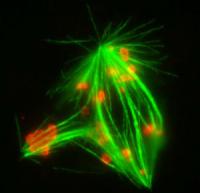
Abnormal mitotic spindle, whose deformation is caused by defective cell division control. The chromosomes are dyed red, the microtubules green. When cells divide, control mechanisms ensure that the genetic material, in other words the chromosomes, is correctly distributed to the daughter cells. Researchers at the Max Planck Institute for Molecular Genetics in Berlin have now explained the molecular principles of these control processes. The so-called checkpoint kinases, i.e. the enzymes which perform this controlling, are not directly associated only with the chromosomes, as was previously assumed to be the case. On the contrary, they interact with a different category of proteins which are involved in the development of the cell division spindle.
This finding is highly significant, since incorrect distribution of the chromosomes can lead to abnormalities and diseases such as cancer. The new understanding of this process will in turn promote a better understanding of the molecular principles of the development of cancer (Science, October 27, 2006).
The rod-shaped filaments of the microtubules are responsible for dividing the chromosomes in a cell. They form a connection between the starting point in the chromosomes, the kinetochors, and the centrosome. The centrosome organizes the spindle-shaped arrangement of the microtubule filaments in the cell by means of gamma tubulin ring complexes. Until now it was assumed that control of even distribution of chromosomes was only monitored by the checkpoint kinases in the kinetochors. When microtubules are correctly attached to the kinetochors, these kinases then inform the cell that a precise distribution of chromosomes can be carried out.
Scientists at the Max Planck Institute for Molecular Genetics in Berlin have now discovered that the checkpoint kinases are also associated with the gamma tubulin ring complex proteins. Accordingly, the researchers have proved that these checkpoint kinases also exist alongside the centrosome and perform their function there. This is a crucial new finding, since it shows that the correct organization of these filaments at both ends is important for correctly distributing the chromosomes during cell division (see picture).
Another surprising finding is that these control mechanisms function independently of the integrity of the kinetochors or the centrosomes. This reveals that a cell has widely differing mechanisms for controlling cell division and monitors these directly at the level of protein complexes.
These findings are extremely important for the understanding of cell division regulation, which is often disrupted in cancer cells. The checkpoint kinases in cancer cells are frequently modified or present in incorrect quantity ratios. In their next step, the researchers plan to carry out targeted analysis of the molecular reactions between the different regulatory proteins and then investigate how these interactions differ in healthy cells and cancer cells. Long term, this could lead to the development of new diagnostic or therapeutic strategies. Source : Max-Planck-Gesellschaft
 Print Article
Print Article Mail to a Friend
Mail to a Friend
